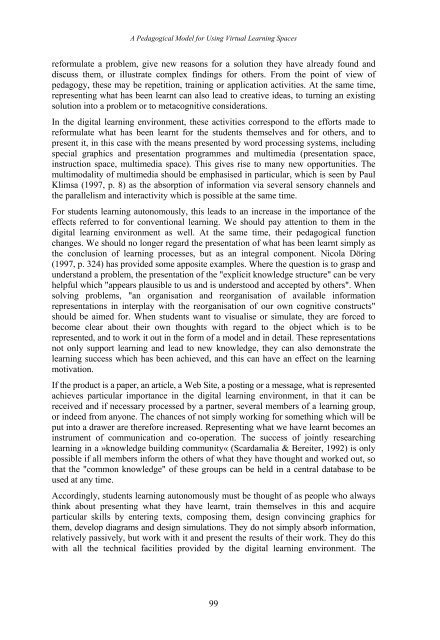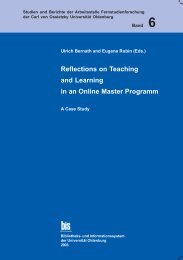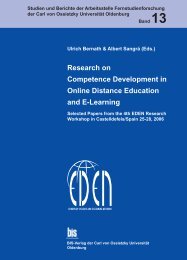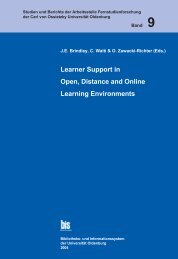Distance Education in Transition - Master of Distance Education ...
Distance Education in Transition - Master of Distance Education ...
Distance Education in Transition - Master of Distance Education ...
Create successful ePaper yourself
Turn your PDF publications into a flip-book with our unique Google optimized e-Paper software.
A Pedagogical Model for Us<strong>in</strong>g Virtual Learn<strong>in</strong>g Spaces<br />
reformulate a problem, give new reasons for a solution they have already found and<br />
discuss them, or illustrate complex f<strong>in</strong>d<strong>in</strong>gs for others. From the po<strong>in</strong>t <strong>of</strong> view <strong>of</strong><br />
pedagogy, these may be repetition, tra<strong>in</strong><strong>in</strong>g or application activities. At the same time,<br />
represent<strong>in</strong>g what has been learnt can also lead to creative ideas, to turn<strong>in</strong>g an exist<strong>in</strong>g<br />
solution <strong>in</strong>to a problem or to metacognitive considerations.<br />
In the digital learn<strong>in</strong>g environment, these activities correspond to the efforts made to<br />
reformulate what has been learnt for the students themselves and for others, and to<br />
present it, <strong>in</strong> this case with the means presented by word process<strong>in</strong>g systems, <strong>in</strong>clud<strong>in</strong>g<br />
special graphics and presentation programmes and multimedia (presentation space,<br />
<strong>in</strong>struction space, multimedia space). This gives rise to many new opportunities. The<br />
multimodality <strong>of</strong> multimedia should be emphasised <strong>in</strong> particular, which is seen by Paul<br />
Klimsa (1997, p. 8) as the absorption <strong>of</strong> <strong>in</strong>formation via several sensory channels and<br />
the parallelism and <strong>in</strong>teractivity which is possible at the same time.<br />
For students learn<strong>in</strong>g autonomously, this leads to an <strong>in</strong>crease <strong>in</strong> the importance <strong>of</strong> the<br />
effects referred to for conventional learn<strong>in</strong>g. We should pay attention to them <strong>in</strong> the<br />
digital learn<strong>in</strong>g environment as well. At the same time, their pedagogical function<br />
changes. We should no longer regard the presentation <strong>of</strong> what has been learnt simply as<br />
the conclusion <strong>of</strong> learn<strong>in</strong>g processes, but as an <strong>in</strong>tegral component. Nicola Dör<strong>in</strong>g<br />
(1997, p. 324) has provided some apposite examples. Where the question is to grasp and<br />
understand a problem, the presentation <strong>of</strong> the "explicit knowledge structure" can be very<br />
helpful which "appears plausible to us and is understood and accepted by others". When<br />
solv<strong>in</strong>g problems, "an organisation and reorganisation <strong>of</strong> available <strong>in</strong>formation<br />
representations <strong>in</strong> <strong>in</strong>terplay with the reorganisation <strong>of</strong> our own cognitive constructs"<br />
should be aimed for. When students want to visualise or simulate, they are forced to<br />
become clear about their own thoughts with regard to the object which is to be<br />
represented, and to work it out <strong>in</strong> the form <strong>of</strong> a model and <strong>in</strong> detail. These representations<br />
not only support learn<strong>in</strong>g and lead to new knowledge, they can also demonstrate the<br />
learn<strong>in</strong>g success which has been achieved, and this can have an effect on the learn<strong>in</strong>g<br />
motivation.<br />
If the product is a paper, an article, a Web Site, a post<strong>in</strong>g or a message, what is represented<br />
achieves particular importance <strong>in</strong> the digital learn<strong>in</strong>g environment, <strong>in</strong> that it can be<br />
received and if necessary processed by a partner, several members <strong>of</strong> a learn<strong>in</strong>g group,<br />
or <strong>in</strong>deed from anyone. The chances <strong>of</strong> not simply work<strong>in</strong>g for someth<strong>in</strong>g which will be<br />
put <strong>in</strong>to a drawer are therefore <strong>in</strong>creased. Represent<strong>in</strong>g what we have learnt becomes an<br />
<strong>in</strong>strument <strong>of</strong> communication and co-operation. The success <strong>of</strong> jo<strong>in</strong>tly research<strong>in</strong>g<br />
learn<strong>in</strong>g <strong>in</strong> a »knowledge build<strong>in</strong>g community« (Scardamalia & Bereiter, 1992) is only<br />
possible if all members <strong>in</strong>form the others <strong>of</strong> what they have thought and worked out, so<br />
that the "common knowledge" <strong>of</strong> these groups can be held <strong>in</strong> a central database to be<br />
used at any time.<br />
Accord<strong>in</strong>gly, students learn<strong>in</strong>g autonomously must be thought <strong>of</strong> as people who always<br />
th<strong>in</strong>k about present<strong>in</strong>g what they have learnt, tra<strong>in</strong> themselves <strong>in</strong> this and acquire<br />
particular skills by enter<strong>in</strong>g texts, compos<strong>in</strong>g them, design conv<strong>in</strong>c<strong>in</strong>g graphics for<br />
them, develop diagrams and design simulations. They do not simply absorb <strong>in</strong>formation,<br />
relatively passively, but work with it and present the results <strong>of</strong> their work. They do this<br />
with all the technical facilities provided by the digital learn<strong>in</strong>g environment. The<br />
99





